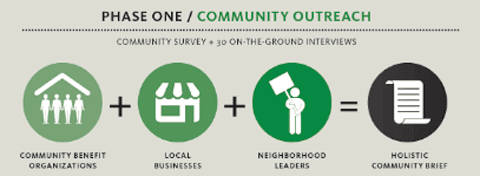During a recent Code for America salon featuring Nicholas Hanauer and Eric Liu, authors of The Gardens of Democracy, discussion centered on the need for a new conceptualization of the relationship between government and the governed. The “new citizenship” requires that we no longer view ourselves as the passive recipients of government services and disservices. We must take responsibility for our communities and ourselves, for “society becomes how you behave.”
 The “new citizen” speaks. (Image courtesy of Neighborland.com)
The “new citizen” speaks. (Image courtesy of Neighborland.com)
Later, at OakX’s Data-Driven City, an open data/open government event in Oakland, a participant noted that allowing access to previously hidden government data requires a shift in attitude and operation for government. While the Code for America salon focused on how citizens should take charge of the democratic process, the message of the OakX discussion was that government must adapt to the “new citizens” and their pesky need for data, information, and inclusion.
Meanwhile, hackathons are popping up everywhere—Campus Party, Random Hacks of Kindness, Weekend Movement, Social Hackathon, and Code4Democracy—and the technologists, designers, and innovators that attend are trying to create solutions to the civic and social problems that plague our communities.
All of these discussions and events make it clear that there is a new-found civic engagement in the air. But to what end? Good intentions abound in the civic and social app movement to which all of these events contribute. What are missing are impactful solutions—you can’t create a solution if you don’t really understand the problem. As one prospective hacker put it, “I want to build something useful but I don’t know what the problems are that we’re supposed to solve.”
This is where nonprofits—the organizations that are wholly dedicated to understanding specific social problems and delivering services to address those problems—should come in. So, why aren’t they participating in the movement?
Are you enjoying this article? Read more like this, plus SSIR's full archive of content, when you subscribe.
The answer, in part, lies in the nonprofit sector’s adherence to an outdated mode of operation, which seeks to solve problems for communities instead of solving problems with communities. Just like government, they need to realize that the “new citizens” are no longer passive recipients of their services; they demand engagement and inclusion. If nonprofits don’t adapt to this paradigm, they will be left out of the conversation.
Nonprofits have the opportunity to lead in this new civic climate. By attending hackathons, for example, they could provide the context and guidance that developers need to build meaningful and adoptable technologies that address social problems. Nonprofits should also open up their product and service design to outside input, involving technologists and designers, as well as interested community members. They should use their expertise to set the agenda—clearly identifying problems and calling for solutions—but instead of trying to create the solutions themselves, they should draw on the input, insights, and ideas of a diversity of stakeholders, looking beyond their staff, their boards, and their funders.
Some nonprofits are already doing this. One great example of how a nonprofit can engage in creative problem solving with a community comes from none other than the World Bank. This past June, a group of developers, data experts, and designers came together over the course of a weekend to demand more open, development-related financial data, and to convince the World Bank to release and publish data on their contracts. The World Bank agreed to release this data, and it was used to build Show Me the Money, an interactive app that promotes transparency in aid by illustrating the flow of World Bank open contract data. This effort shows how an organization, if it is willing to open up its processes and engage with its community members, can crowdsource both problem definitions and solutions to these problems.
Other organizations working with their communities to solve problems include Imagine H20, which hosts competitions for innovative solutions to water issues, and the Urban Strategies Council, which focuses on poverty alleviation and improving outcomes for low-income communities. They use a “community building support process,” which identifies the skills and resources of other stakeholders and community leaders and works to support them, without competition or duplication of effort.
 Creative Currency’s program model. (Image courtesy of Creative Currency)
Creative Currency’s program model. (Image courtesy of Creative Currency)
Finally, the Gray Area Foundation for the Art’s Creative Currency project has involved an extensive process of gathering input from community leaders, local businesses, and social service providers in San Francisco’s mid-Market area to inform the project’s efforts.
At TechSoup Global, we like to say that Web 2.0 moved the dial from what nonprofits have the least of—money—to what they have the most of—community. The time is now to start maximizing that asset.
Support SSIR’s coverage of cross-sector solutions to global challenges.
Help us further the reach of innovative ideas. Donate today.
Read more stories by Sheetal Singh.

